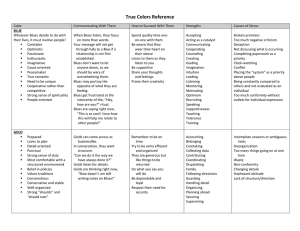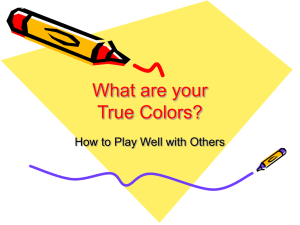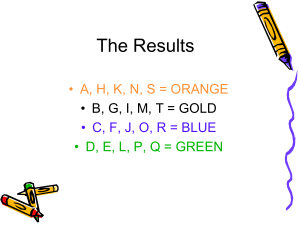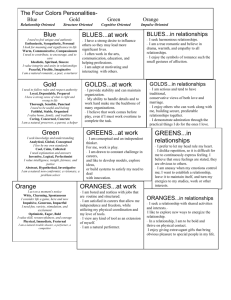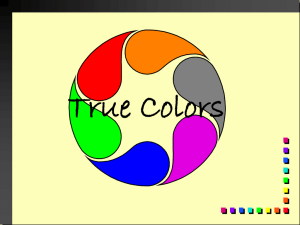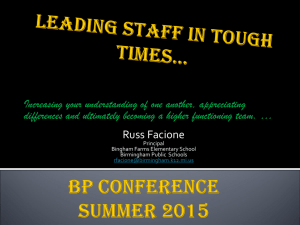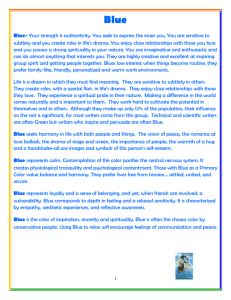What are your True Colors? How to Play Well with Others
advertisement
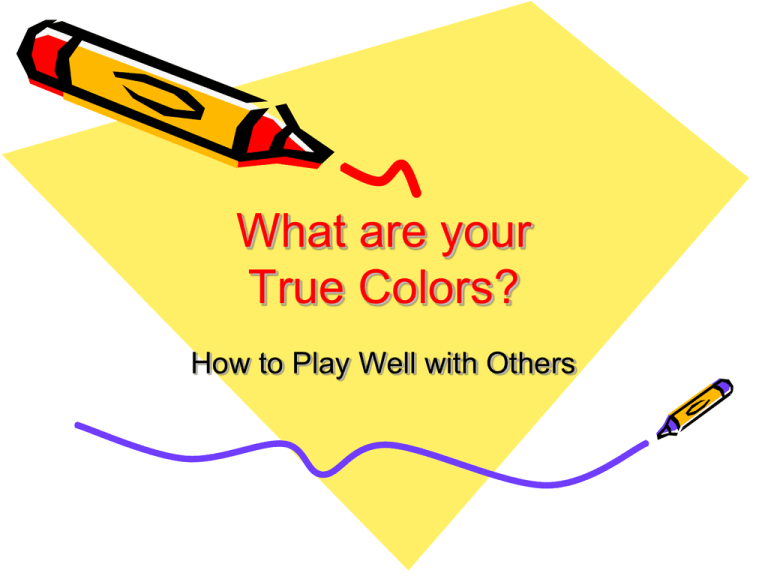
What are your True Colors? How to Play Well with Others In a survey of 20,000 CEO’s, the following were their top ten picks of the most important qualities of effective, productive employees: 10. Creative (15%) 9. Initiative (16%) 8. Humor (16%) 7. Self-motivated (22%) 6. Intelligent (26%) 5. Hard working (27%) 4. Curious (35%) 3. Honest (36%) 2. Team oriented (38%) 1. ETHICAL (49%) The top 2 qualities: ethical and TEAM ORIENTED!!!! Many business owners say they need employees with communication skills and interpersonal skills! “It’s easy to get the players. Getting them to play together, that’s the hard part.” - Baseball Legend Casey Stengel Color Connotations and How this Method Works • What feelings and emotions do you associate with the following colors? • What benefits are there to taking personality tests? • • • • Blue Gold Orange Green Your True Colors Test • Look at each row of horizontal categories of words. Rank the 4 categories from 1 to 4 (4 being most like you and 1 least like you). • Go on to the next horizontal line of categories and do the same. • Be cautious and make sure you rank these according to who you truly feel you are rather than who you would like to be. • Using the letter formula at the bottom, add up the specified letters. • Remember the purpose: this is not to stereotype people; this is to identify commonalities and differences, which will then help us collaborate and expand possibilities. The Analysis 1. 2. 3. 4. Your primary and most dominant: the characteristics listed for this number one spot indicate the ones you feel most comfortable operating with. These are the attributes you use when you are truly being yourself. Your second color has a major influence on the first. In some cases, it shines as brightly as your dominant color. This one does not make as much of an impact. Sorry, “third”! Because these characteristics are least natural to you, you may admire them in others. Or, on the contrary, because they are the least natural, chances are that they are also the least understood, and therefore they are the characteristics that cause the most conflict with others. People often condemn what they themselves lack. The Results • A, H, K, N, S = ORANGE • B, G, I, M, T = GOLD • C, F, J, O, R = BLUE • D, E, L, P, Q = GREEN BLUE Whatever Blues decide to do with their lives, it must involve people! • • • • • • Caretaker Optimistic Passionate Enthusiastic Imaginative Cause oriented • True romantic • Need to be unique • Cooperative rather than competitive • Strong sense of spirituality • People oriented • Peacemaker Communicating with the Blue • When Blues listen, they focus on more than words. • Your message will not get through fully to a Blue if a relationship is not first established. • Blues don’t want to let anyone down, so we should be wary of overwhelming them. • Blues may portray the opposite of what they are feeling. • Blues get frustrated at the insincerity of the, “Hey, how are you?” ritual. • Blues are saying right now, “This is so cool! I love how this will help me relate to other people!” The World vs. Blue Creating STRESS for Blues… - - broken promises Too much negative criticism Deception Not discussing what is occurring Completing paperwork as a priority Clock-watching Conflict Placing the “system” as a priority above people Being constantly compared to others and not evaluated as an individual Too much conformity without outlets for individual expression Succeeding with the Blues… - Spend quality time one-on-one with them - Be aware that they wear their heart on their sleeve - Listen to them as they listen to you - Be supportive - Share your thoughts and feelings - Praise their creativity Good as Gold • • • • • Prepared Loves to plan Detail-oriented Punctual Strong sense of duty • Most comfortable with a structured environment • • • • Belief in policies Values traditions Conscientious Conservative and stable • Well-organized • Strong “shoulds” and “should nots” Communicating with Golds • Golds can come across as businesslike. • In conversation, they want structure. • “Can we do it the way we have always done it?” • Golds listen for details. • Golds are thinking right now, “Slow down! I am still writing notes on Blues!” The World vs. Gold Creating stress for Golds… - Incomplete/ambiguous tasks/answers - Disorganization - Too many things going on at one time - Waste - Non-conformity - Changing details - Haphazard attitude - Lack of structure/direction Succeeding with Golds… - Remember to be on time - Try to be extra efficient and organized - They are generous but like things to be returned - Do what you say you will do - Be dependable and loyal - Respect their need for security Just do it! ORANGE • Extroverted Orange: Tigger (everyone knows when he is around and very little stresses him out) • Introverted Orange: Winnie the Pooh (goes with the flow and only major concern is HONEY!) OUTRAGEOUS ORANGE • Energetic • Desires change • Playful • Master navigator • Natural entertainer • Pushes boundaries • Accepts challenges • Impulsive • Spontaneous • “Just do it!” • Appreciates immediate feedback • Most productive in nonstructured environments Communicating with Oranges • Oranges are confident, loud, and casual • “Now” oriented • Oranges listen for entertainment, usefulness, and relevance • They are constantly looking for opportunities • They want forthright communication • They are trying to accomplish a goal with all communication • When talking to an Orange, capture your information into bitesize pieces • Give Oranges choices and ask for their suggestions The World vs. Orange Creating Stress for Oranges… - Too much responsibility - Redundancy - Deadlines - Rules and regulations - Being stuck at a desk - “how to” directions - Too much attention to product and not enough to performance/results - Abstract concepts Succeeding with the Orange… - Be active and don’t slow them down! - Be spontaneous and fun - Compete in fun when appropriate - Be adventuresome and optimistic - Be energetic and ready to go! Feelin’ Green • • • • • • Problem-solver “Why” mentality Very complex Standard-setter Cool, calm, collected Approaches interpersonal relationships in a logical manner • Intellectual • Work is play and play is work • Need for independence and private time • Driven by competence • Perfectionist • Analytical Communicating with Greens • Greens communicate for the purpose of gaining or sharing information. • Their favorite line is, “And your point is?” • Greens listen for information and want to know the purpose for that particular communication. • Greens usually don’t show emotion. • When talking to a Green, be prepared to defend your position! • Greens are thinking, “How will this help me with people, again? I don’t need help with people. Why would I?” The World vs. Greens Creating stress for Greens… - Not being in charge - Lack of independence - Elaborate use of adjectives - Incompetence - Emotional displays - Lack of options - Inability to use or display knowledge - Small talk - Routine - Social functions Succeeding with Greens… - Be aware of their curiosity about life - Give things that challenge their problem-solving abilities - Respect their need for independence - Know that they are caring even though they may not show their feelings much - Respect their ideas Why is this important? • Think of your possible future careers. Will they involve people? Will they involve communication? Why True Colors? • “Color” watching is only one filter through which to view human behavior. • True color awareness should alter your interactions as you become more aware. • Learning the True Color language and customs of others not only lowers tension and resistance levels, but it also demonstrates the utmost respect. It helps you build relationships. References Miscisin, M. (2005). Showing our True Colors. Sacramento: True Colors, Inc. www.true-colors.com
